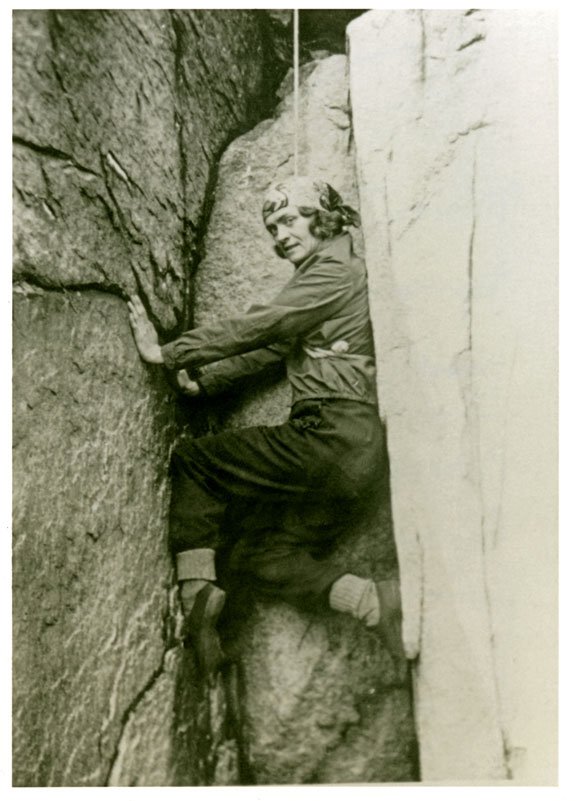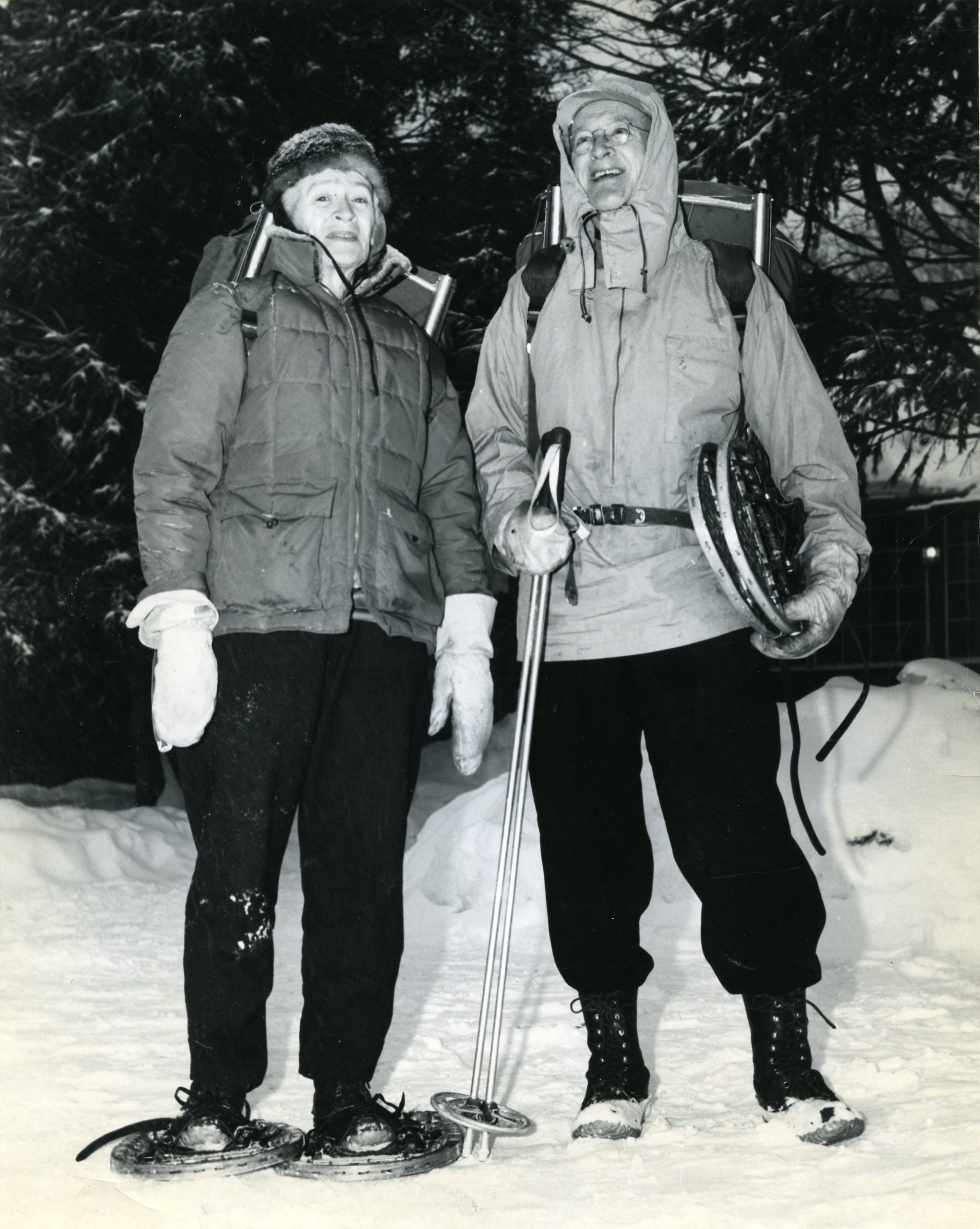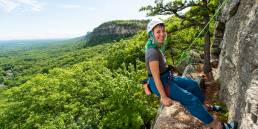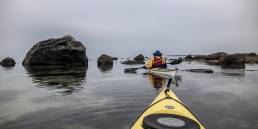Miriam O’Brien Underhill led a life of firsts. One of the Northeast’s most prominent early alpinists, she popularized the idea of “manless” climbing and, in the 1920s and 1930s, made the first all-female ascents of the Aiguille du Peigne, the Grépon, and the Matterhorn. She was also the first woman to summit all of New Hampshire’s 4,000-footers and was a charter member (along with her husband Robert) of the White Mountains Winter Four Thousand Footer Club, completing the endeavor in a single season. One of the U.S.’s first great alpinists, Underhill helped pave the way for generations of Northeast climbers.

Cordée en Féminine
Already an accomplished climber and mountaineer, Underhill (then O’Brien) broke a major barrier for women in 1927 when she and her partner Winifred Marples climbed the iconic Aiguille du Peigne in Chamonix alone and unsupported. Just three days later, she and Alice Damesme made the first women-only traverse of the Grépon, which at the time was considered one of the toughest climbs in the Alps.
Despite being one of the greatest U.S. climbers, there was not always contemporary adulation for Underhill. For instance, after the first female ascent of the Grépon, famed alpinist Étienne Bruhl remarked, “The Grépon has disappeared. Now that it has been done by two women alone, no self-respecting man can undertake it. A pity, too, because it used to be a very good climb.” Others treated the ascent as an anomaly, with The Alpine Journal—the annual publication by the Alpine Club of London—noting, “Few ladies, even in these days are even capable of mountaineering unaccompanied.”
Nevertheless, Underhill quite enjoyed that style of climbing. As she described in her memoir Give Me the Hills:
“The one who goes up first on the rope has even more fun, as he solves the immediate problems of technique, tactics and strategy as they occur. And if he is, as he usually is, the leader, the one who carries the responsibility for the expedition, he tastes the supreme joy…The exercise of proper judgment is of more consequence than in most sports, for mountaineering (like lion-hunting or white-water canoeing!) is a game with real and sometimes drastic penalty for failure…I saw no reason, why women, ipso facto, should be incapable of leading a good climb.”
In the following years, Underhill continued to make manless climbing a reality. In 1932, she teamed up with Damesme once again to make the first all-female ascent of the Matterhorn. All told, she made nine climbs cordée en féminine between 1929 and 1932. In 1934, the National Geographic Society published an article she wrote encapsulating her all-female ascent titled “Manless Alpine Climbing: The First Woman to Scale the Grépon, the Matterhorn and Other Famous Peaks Without Masculine Support.”
Underhill’s Northeast Training Ground
Underhill’s European success had its origins in years she spent romping in the Whites, exploring Mount Washington’s ravines and rock climbing in New England’s then-fledgling climbing areas. Miriam, along with a group of notable climbers from the era, would visit crags that remain popular today such as Crow Hill, the Quincy Quarries, and Pawtuckaway. Among those notable climbers was her younger brother Lincoln, an accomplished climber in his own right and whose first ascents include both Cannon and the Eaglet, routes he put up with Robert Underhill—Miriam’s future husband.

The Northeast’s Power Couple
Marriage put an end to Miriam’s women-only climbing, but not her passion for the mountains. She stated in her memoir, “Manless climbing [was] fun for a while, but this other arrangement is better!” While happy to share a rope with her husband, she wasn’t about to forgo the sharp end and the couple shared leads on climbs across the country for the next few decades. Additionally, they continued to share a love of the White Mountains.
In 1960, the couple, then with two adult sons, put another indelible mark on the region, becoming the third and fourth members of the White Mountains 4,000-footer club when they summited all 46 peaks. (Today there are 48 4,000-footers, but South Twin was not added until 1975, and Bondcliff was added in 1980.) The Underhills’ accomplishment is especially impressive considering mountains like Cabot, Waumbek, Tom, Zealand, Owl’s Head, West Bond, and the Hancocks were all without maintained trails at the time.
That same year, the Underhills established the Winter 4,000-Footer Club, completing their effort on Mount Jefferson in below-zero temperatures with winds howling at speeds more than 70 mph. At the time of their accomplishment, Miriam was 62 and Robert 71. Their rules for the Winter 4,000-Footers Club were simple: Climbs had to occur during calendar winter (“‘Snow on the ground’ and other namby-pamby criteria definitely did not count.”)
Underhill’s contribution to the region extended well beyond physical activities. Miriam edited Appalachia—the AMC’s journal—in the 1950s and 1960s, a position once held by her husband, who edited Appalachia from 1928 to 1934. Miriam’s photos also grace the AMC’s book Mountain Flowers of New England.

Underhill’s Legacy
The Underhills’ legacy extends well beyond New England; the couple took climbing trips to Wyoming’s Tetons and Wind River Range (where you’ll find Miriam’s Peak and Bob’s Towers standing next to each other); Idaho’s Sawtooth Mountains; and Montana’s Swan, Mission, and Beartooth ranges. Along with trips to Europe, Miriam climbed the Matterhorn for the third time in 1952.
Today, the Robert and Miriam Underhill Award is given annually by the American Alpine Club to “a person who, in the opinion of the selection committee, has demonstrated the highest level of skill in the mountaineering arts and who, through the application of this skill, courage, and perseverance, has achieved outstanding success in the various fields of mountaineering endeavor.”
Tim Peck and Doug Martland
Tim and Doug met long ago at the Eastern Mountain Sports in Canton, Massachusetts. Bonding over a love of slick Quincy Quarry granite, White Mountain sufferfests, and scheming up adventures while folding tee-shirts, today Tim and Doug collaborate to write about their favorite outdoor activities and occasionally get nostalgic about tee-shirt tables.
Related Posts
April 24, 2024
What to Bring When Road Tripping with Your Dog
Prepare for the ultimate road trip with…




